With Angkor Wat waiting for us in Siem Reap we packed up early and headed North out of Phnom Penh and along the Mekong / Vietnamese border to Kampong Cham …. aka “Skun Insect market”.
 And before the doors had even fully opened three little kids carrying live tarantulas in their hands, hair and mouths had boarded the bus. The market is primarily for the trade of insects and other various meats and produce but is a common stop for tourist buses due to the unique culture of eating scorpions, tarantulas, ants and grubs. The kids of the vendors have, over the years, earnt themselves a name for taking great pleasure in winding up arachnophobic visitors and calmly posing for pictures with the insects chilling in their mouths or sprawled across their faces.
And before the doors had even fully opened three little kids carrying live tarantulas in their hands, hair and mouths had boarded the bus. The market is primarily for the trade of insects and other various meats and produce but is a common stop for tourist buses due to the unique culture of eating scorpions, tarantulas, ants and grubs. The kids of the vendors have, over the years, earnt themselves a name for taking great pleasure in winding up arachnophobic visitors and calmly posing for pictures with the insects chilling in their mouths or sprawled across their faces.
Tarantulas are probably the only kind of spider I don’t hate so I happily held them or let them crawl on my arms but not everyone was so lucky – the eldest of the kids seemed to love stealthily putting a tarantula on an unsuspecting tourist and then running off! Sometimes even asking them for a tip of a few riel to “help” remove the poor spider. Definitely not one for the faint hearted but credit where credit’s due – those kids were nifty little influencers and businesspeople.
We then headed West, skirting along the banks of the Tonlé Sap lake towards Siem Reap – one of the biggest cities in Cambodia known mostly for being home to the Angkor Wat temple complex. But not before a quick lunch stop at a lakeside services where each table was in it’s own little straw hut (Cambodia was a year ahead in the social distancing game!), there was a little old man playing soft Cambodian songs on a string instrument called a Tro and little sandwich bags of coloured water hung from the roof as a (kind of a little bit but not really) more eco-friendly insect repellent.
 We also made a sudden and impromptu roadside stop in the Kampong Thom province where families were processing raw rice using traditional bodyweight machinery that resembled a one-person seesaw. It took about another 5 hours to get to Siem Reap from there and the closer you got, the bumpier and more pot-holey the roads became but what better way to get rid of a bit of travel sickness than with some off-road quad biking right?
We also made a sudden and impromptu roadside stop in the Kampong Thom province where families were processing raw rice using traditional bodyweight machinery that resembled a one-person seesaw. It took about another 5 hours to get to Siem Reap from there and the closer you got, the bumpier and more pot-holey the roads became but what better way to get rid of a bit of travel sickness than with some off-road quad biking right?
 I had been briefed by my mum before boarding my flight to Bangkok: “don’t do any drugs”, “don’t go out at night” and “don’t ride any motorbikes” …. and well I’d already broken two of those rules in Vietnam alone plus she never mentioned anything about quad-biking so I was more than happy to sign my life away and don a very loose helmet! I’m not much of an adrenaline junkie but there was something so fun about hurtling along the bumpy roads at break neck speed – although the speed wasn’t a choice, I couldn’t actually reach the accelerator to release it any further. Most people (smart or boring, you decide) dodged the deep muddy puddles that filled in all the pot holes but I on the other hand just ploughed right through them and told myself that the mud was probably good for my skin.
I had been briefed by my mum before boarding my flight to Bangkok: “don’t do any drugs”, “don’t go out at night” and “don’t ride any motorbikes” …. and well I’d already broken two of those rules in Vietnam alone plus she never mentioned anything about quad-biking so I was more than happy to sign my life away and don a very loose helmet! I’m not much of an adrenaline junkie but there was something so fun about hurtling along the bumpy roads at break neck speed – although the speed wasn’t a choice, I couldn’t actually reach the accelerator to release it any further. Most people (smart or boring, you decide) dodged the deep muddy puddles that filled in all the pot holes but I on the other hand just ploughed right through them and told myself that the mud was probably good for my skin.
After what felt like a full day of being on transport we only had one more to get back to the hotel – the back of someone’s fancy flatbed 4×4 ….and it was then that I realised I probably jumped the gun by complaining about the pot-holiness of the roads from the safety of a bus that at least had seatbelts and a roof.





 Unsurprisingly for August in South East Asia it was raining when I arrived but that didn’t stop us from taking a sunset cyclo tour around the city to orientate ourselves. Cyclos being these strange bike/tuktuk hybrids, comparable to those little tented bike attachments you put little kids in except in the adult version you sit in the front and the cyclist sits behind you and pedals. The man pedalling my cyclo thing either didn’t know how to adjust his bike or just simply enjoyed pain as he couldn’t reach either of the
Unsurprisingly for August in South East Asia it was raining when I arrived but that didn’t stop us from taking a sunset cyclo tour around the city to orientate ourselves. Cyclos being these strange bike/tuktuk hybrids, comparable to those little tented bike attachments you put little kids in except in the adult version you sit in the front and the cyclist sits behind you and pedals. The man pedalling my cyclo thing either didn’t know how to adjust his bike or just simply enjoyed pain as he couldn’t reach either of the  pedals! The cycloes took us to several monuments around the city that tourists usually enjoy (despite there being absolutely nobody around). First stop was the Yeay Penh monument, also known as “Our lady the founder of the city”, legend has it that Yeay Penh was a villager from the outskirts of (what is now) Phnom Penh, one day a tree washed up in her village containing solid gold Buddhas which she took to be a sign that the city needed a temple and thus she founded Wat Phnom – the main temple in Phnom Penh…..which is where we headed next. Our final stops on the cyclos took us to the independence monument which represents the independence from France in the 50’s however I was more entranced by a picture of the Cambodian queen (don’t quote me on that being her official title!) that looked spookily similar to a young Queen Liz!
pedals! The cycloes took us to several monuments around the city that tourists usually enjoy (despite there being absolutely nobody around). First stop was the Yeay Penh monument, also known as “Our lady the founder of the city”, legend has it that Yeay Penh was a villager from the outskirts of (what is now) Phnom Penh, one day a tree washed up in her village containing solid gold Buddhas which she took to be a sign that the city needed a temple and thus she founded Wat Phnom – the main temple in Phnom Penh…..which is where we headed next. Our final stops on the cyclos took us to the independence monument which represents the independence from France in the 50’s however I was more entranced by a picture of the Cambodian queen (don’t quote me on that being her official title!) that looked spookily similar to a young Queen Liz! order to prevent starvation.
order to prevent starvation.  After lunch we headed up the hill to the aforementioned Wat Phnom, a beautiful almost bell-shaped gloriously white stupa atop a hill overlooking the city centre and of course, our lady founder of the city. Throughout the whole trip through South East Asia I had seen religious offerings in different forms, sometimes little shrines with candles and flowers (Pak Beng), sometimes miniature statues (Vientiane) and sometimes boxes of Americanised snacks (Hanoi) but Phnom Penh was the first time I had ever seen raw bacon offered to the statues outside of the temple.
After lunch we headed up the hill to the aforementioned Wat Phnom, a beautiful almost bell-shaped gloriously white stupa atop a hill overlooking the city centre and of course, our lady founder of the city. Throughout the whole trip through South East Asia I had seen religious offerings in different forms, sometimes little shrines with candles and flowers (Pak Beng), sometimes miniature statues (Vientiane) and sometimes boxes of Americanised snacks (Hanoi) but Phnom Penh was the first time I had ever seen raw bacon offered to the statues outside of the temple. The evening was planned to be a relaxing and calm sail down the river however first, as in every city I think I’ve ever been to, you just have to pay a visit to the main market. In Phnom Penh the central market is this incredibly glamorous and flamboyant structure that seems as though it’s been transferred from a middle eastern country and plopped down in the middle of the city. The inside, if you looked up, looked like Central Station in New York yet if you looked straight ahead there were jewellers and tailors alongside live/half-dead fish thrashing about in the fish stalls, unidentifiable and mind blowingly bizarre tropical fruits in the grocer stalls and people everywhere! I couldn’t and still can’t decide whether I found it intriguing or overwhelming-either way it was probably my favourite market in the whole of South East Asia.
The evening was planned to be a relaxing and calm sail down the river however first, as in every city I think I’ve ever been to, you just have to pay a visit to the main market. In Phnom Penh the central market is this incredibly glamorous and flamboyant structure that seems as though it’s been transferred from a middle eastern country and plopped down in the middle of the city. The inside, if you looked up, looked like Central Station in New York yet if you looked straight ahead there were jewellers and tailors alongside live/half-dead fish thrashing about in the fish stalls, unidentifiable and mind blowingly bizarre tropical fruits in the grocer stalls and people everywhere! I couldn’t and still can’t decide whether I found it intriguing or overwhelming-either way it was probably my favourite market in the whole of South East Asia. Trying to erase the image of the half-dead fish from my brain we made our way back to the promenade by the palace to get on a river boat for a sunset cruise of the Tonle Sap and Mekong rivers. Despite being a pretentious way to see the city it was undeniably the best way to see it and to see how the city was truly divided by wealth. On the one side of the Tonle Sap river you had the city centre all lit up and sparkingly in the night with it’s high-rise hotels, casinos and business districts yet on the other side, the Mekong side, just out of sight of the palace, you had a floating “village” of about a thousand local people who lived in boats with no electricity – probably not even 500m from the main promenade. So basically, from the boat, if you looked left it looked like a sparkly city and if you looked right you could see nothing but pitch black and the occasional wave reflecting the city light.
Trying to erase the image of the half-dead fish from my brain we made our way back to the promenade by the palace to get on a river boat for a sunset cruise of the Tonle Sap and Mekong rivers. Despite being a pretentious way to see the city it was undeniably the best way to see it and to see how the city was truly divided by wealth. On the one side of the Tonle Sap river you had the city centre all lit up and sparkingly in the night with it’s high-rise hotels, casinos and business districts yet on the other side, the Mekong side, just out of sight of the palace, you had a floating “village” of about a thousand local people who lived in boats with no electricity – probably not even 500m from the main promenade. So basically, from the boat, if you looked left it looked like a sparkly city and if you looked right you could see nothing but pitch black and the occasional wave reflecting the city light.
 On the second day in Ho Chi Minh I took an organised trip to the Cu Chi tunnels, about an hour north of the city. There is a very long and complex history with the Cu Chi tunnels but to summarise, during the Vietnam war, the Guerilla Viet Cong troops dug thousands of miles worth of tunnels to be used for safe passage and to relay supplies and communication across an area that was heavily bombed by the Americans. In some cases, entire populations of people relocated below ground to protect themselves from the incessant bombing.
On the second day in Ho Chi Minh I took an organised trip to the Cu Chi tunnels, about an hour north of the city. There is a very long and complex history with the Cu Chi tunnels but to summarise, during the Vietnam war, the Guerilla Viet Cong troops dug thousands of miles worth of tunnels to be used for safe passage and to relay supplies and communication across an area that was heavily bombed by the Americans. In some cases, entire populations of people relocated below ground to protect themselves from the incessant bombing. American and South Vietnamese soldiers attempted to find and catch the Viet Cong troops by sending in soldiers they called “tunnel rats” to navigate sections of the tunnels and detect booby-traps hidden by the Viet Cong. However the Viet Cong had meticulously planned the tunnels by hiding the entrances and disguising air and smoke vents as ant hills and bushes. The Americans were much more heavily armed so the Viet Cong troops booby-trapped both the tunnels and the surrounding areas with a series of more traditional yet ingenious traps, most of which involved some sort of sharpened spike upon which enemy soldiers were impaled!
American and South Vietnamese soldiers attempted to find and catch the Viet Cong troops by sending in soldiers they called “tunnel rats” to navigate sections of the tunnels and detect booby-traps hidden by the Viet Cong. However the Viet Cong had meticulously planned the tunnels by hiding the entrances and disguising air and smoke vents as ant hills and bushes. The Americans were much more heavily armed so the Viet Cong troops booby-trapped both the tunnels and the surrounding areas with a series of more traditional yet ingenious traps, most of which involved some sort of sharpened spike upon which enemy soldiers were impaled! Over the course of the Vietnam war, and upon the fall of Saigon, nearly 50,000 Vietnamese men and women were said to have lost their lives defending the Cu Chi tunnels. Nowadays, the government has protected the tunnels to allow visitors from around the world to come and learn the history and experience some of the reinforced tunnels firsthand. Many of the air/smoke vents are still standing some nearly 50 years later and the booby traps have been recreated (safely!) in an open-air museum to allow visitors to better picture how the tunnels once looked to both the Viet Cong and American soldiers. However, for reasons that I do not understand, a shooting range was also built on the site to allow tourists to shoot AK-47s – this meant that (perhaps realistically?) as you walk amongst the tunnels there is the constant sound of gunfire.
Over the course of the Vietnam war, and upon the fall of Saigon, nearly 50,000 Vietnamese men and women were said to have lost their lives defending the Cu Chi tunnels. Nowadays, the government has protected the tunnels to allow visitors from around the world to come and learn the history and experience some of the reinforced tunnels firsthand. Many of the air/smoke vents are still standing some nearly 50 years later and the booby traps have been recreated (safely!) in an open-air museum to allow visitors to better picture how the tunnels once looked to both the Viet Cong and American soldiers. However, for reasons that I do not understand, a shooting range was also built on the site to allow tourists to shoot AK-47s – this meant that (perhaps realistically?) as you walk amongst the tunnels there is the constant sound of gunfire. Later on during my trip to Ho Chi Minh I paid a visit to the War Remnants Museum in the city centre of Ho Chi Minh. This was where I could see photos, statements and artefacts from the war in general whereas Cu Chi told primarily the history of the tunnels. I’m a museum lover anyway but none had ever moved me to tears before this one. Not only was the museum beautifully and respectfully organised (with spaces to sit and watch documentaries and news recordings from the war) but they provided employment for people handicapped by the war or by Agent Orange who might struggle to find adapted work elsewhere in the city.
Later on during my trip to Ho Chi Minh I paid a visit to the War Remnants Museum in the city centre of Ho Chi Minh. This was where I could see photos, statements and artefacts from the war in general whereas Cu Chi told primarily the history of the tunnels. I’m a museum lover anyway but none had ever moved me to tears before this one. Not only was the museum beautifully and respectfully organised (with spaces to sit and watch documentaries and news recordings from the war) but they provided employment for people handicapped by the war or by Agent Orange who might struggle to find adapted work elsewhere in the city. Unfortunately, these narratives by the photographers and journalists were often filled with the terror and trauma of knowing that the subjects of their photos and articles would not have survived – some were even murdered in front of them. The photos and their accompanying stories raised a lot of moral questions for me: how could anyone stand by and photograph children dying, men being murdered or whole villages being burnt to nothing? But I vividly remember, on the corner of the second floor gallery, a photo of a Vietnamese man begging for his life with a gun pointed to his head, the photographer had written beneath it “I said wait as I took the picture but as I turned around I heard a gunshot”. I wish to say that that was the most haunting picture/story in the museum but it was far from it.
Unfortunately, these narratives by the photographers and journalists were often filled with the terror and trauma of knowing that the subjects of their photos and articles would not have survived – some were even murdered in front of them. The photos and their accompanying stories raised a lot of moral questions for me: how could anyone stand by and photograph children dying, men being murdered or whole villages being burnt to nothing? But I vividly remember, on the corner of the second floor gallery, a photo of a Vietnamese man begging for his life with a gun pointed to his head, the photographer had written beneath it “I said wait as I took the picture but as I turned around I heard a gunshot”. I wish to say that that was the most haunting picture/story in the museum but it was far from it.
 Built in 2017 by Vietnamese architects Vu Viet Anh, Tran Quang Hung and Nguyen Quang Huu Tuan from Ho Chi Minh city, it was contracted by SunGroup (resort giants!) as a tourist attraction to bring visitors to their new-ish SunWorld resort: Ba Na hills on the outskirts of DaNang. But it wasn’t just for looks, it also functioned as a link between the cable car station and the hill gardens meanwhile providing a stunning panoramic view over the rolling green hills, the French colonial city of Da Nang and the East Vietnam Sea.
Built in 2017 by Vietnamese architects Vu Viet Anh, Tran Quang Hung and Nguyen Quang Huu Tuan from Ho Chi Minh city, it was contracted by SunGroup (resort giants!) as a tourist attraction to bring visitors to their new-ish SunWorld resort: Ba Na hills on the outskirts of DaNang. But it wasn’t just for looks, it also functioned as a link between the cable car station and the hill gardens meanwhile providing a stunning panoramic view over the rolling green hills, the French colonial city of Da Nang and the East Vietnam Sea. The bridge (actually named Cầu Vàng in Vietnamese) gained fame almost immediately after its opening in 2018 thanks to Instagrammers and travel bloggers across the globe and soon earnt its name as the Golden Hands Bridge. However what isn’t commonly known is that just a 500m cable car ride away, in the heart of the Ba Na hills resort, is a full-blown theme park and European style resort complete with a Bavarian Oompah band, a not-to-scale replica of the Notre Dame and a 6km long and nearly 2km high cable car (not for the faint-hearted).
The bridge (actually named Cầu Vàng in Vietnamese) gained fame almost immediately after its opening in 2018 thanks to Instagrammers and travel bloggers across the globe and soon earnt its name as the Golden Hands Bridge. However what isn’t commonly known is that just a 500m cable car ride away, in the heart of the Ba Na hills resort, is a full-blown theme park and European style resort complete with a Bavarian Oompah band, a not-to-scale replica of the Notre Dame and a 6km long and nearly 2km high cable car (not for the faint-hearted). It depends on what you plan to do/see. If you are a fan of theme parks – absolutely! If you really want to see a stunning view from the top of the bridge out over the surroundings – absolutely! If you seek to see peculiar places and buildings – absolutely! If you don’t mind big crowds or if you have an extra day to kill in DaNang – absolutely! The cable car to get to the main entrance is reason to visit in itself and if you are European and are missing French pastries, Bratwursts or proper good beer – this is the place to be. Furthermore, if you are Vietnamese and really fancy a quick and affordable trip to Europe – once again this place is worth a visit.
It depends on what you plan to do/see. If you are a fan of theme parks – absolutely! If you really want to see a stunning view from the top of the bridge out over the surroundings – absolutely! If you seek to see peculiar places and buildings – absolutely! If you don’t mind big crowds or if you have an extra day to kill in DaNang – absolutely! The cable car to get to the main entrance is reason to visit in itself and if you are European and are missing French pastries, Bratwursts or proper good beer – this is the place to be. Furthermore, if you are Vietnamese and really fancy a quick and affordable trip to Europe – once again this place is worth a visit. However, and I hope my blog post addresses this, it is NOT at all what you see in pictures. It is horrifically overcrowded, at its worst, I couldn’t even get my hand into my pocket because I was squashed up so much and I could feel the breath of about 5 other people on my face and neck. I personally found the whole day extremely stressful but… had I been warned of this beforehand it probably wouldn’t have been half as bad as it seemed.
However, and I hope my blog post addresses this, it is NOT at all what you see in pictures. It is horrifically overcrowded, at its worst, I couldn’t even get my hand into my pocket because I was squashed up so much and I could feel the breath of about 5 other people on my face and neck. I personally found the whole day extremely stressful but… had I been warned of this beforehand it probably wouldn’t have been half as bad as it seemed. Before you even reach that god-awful cable car you have to make your way to Hoa Hinh … aka the cable car station and coach car park so large it gives Disneyland a run for its money! From DaNang (the nearest city) it is only a 20km/40 minute drive through the beautiful lush hills or you can take the once-daily DaNang Green bus for as little as £5 that takes approximately an hour. From Hoi An (where I went from) it is a little bit further but still only about a 50km/90 minute drive. You can also take the bus but it takes nearly 4 hours as you would have to change in DaNang first. Alternatively, tourist offices/travel agencies in both DaNang, Hoi An and other nearby cities offer daytrips for between £30 and £100 and if you go as a family this is probably the best choice.
Before you even reach that god-awful cable car you have to make your way to Hoa Hinh … aka the cable car station and coach car park so large it gives Disneyland a run for its money! From DaNang (the nearest city) it is only a 20km/40 minute drive through the beautiful lush hills or you can take the once-daily DaNang Green bus for as little as £5 that takes approximately an hour. From Hoi An (where I went from) it is a little bit further but still only about a 50km/90 minute drive. You can also take the bus but it takes nearly 4 hours as you would have to change in DaNang first. Alternatively, tourist offices/travel agencies in both DaNang, Hoi An and other nearby cities offer daytrips for between £30 and £100 and if you go as a family this is probably the best choice. Be prepared for the weather. When I visited it was sunny, clear, hot and humid but being in the hills and by the coast it can quickly get foggy, cloudy and rainy. Try not to be disappointed if your view from the bridge is 90% fog.
Be prepared for the weather. When I visited it was sunny, clear, hot and humid but being in the hills and by the coast it can quickly get foggy, cloudy and rainy. Try not to be disappointed if your view from the bridge is 90% fog.
 Hoi An is often dubbed the “City of lanterns” or the “City of tailors” but if I were to describe it in one word I would say romantic. It had charm, character, vibrance and beauty and was overall my favourite place in Vietnam. Not only was it a city literally full to the brim of lanterns and tailors but it was also, like Venice, floating amongst miles upon miles of canals and waterways spanned by ornate little bridges and filled with colourful little canoes and boats.
Hoi An is often dubbed the “City of lanterns” or the “City of tailors” but if I were to describe it in one word I would say romantic. It had charm, character, vibrance and beauty and was overall my favourite place in Vietnam. Not only was it a city literally full to the brim of lanterns and tailors but it was also, like Venice, floating amongst miles upon miles of canals and waterways spanned by ornate little bridges and filled with colourful little canoes and boats. A bit of history on Hoi An: it is an ancient port on the coast in central Vietnam and a mixture of various architectural styles from different eras and styles, most of which have survived the test of time and are still standing today as attractions to visitors from around the globe. Speaking of which, Hoi An, for it’s size, is extremely extremely busy. Even in the off-season when I visited, it was still teeming with thousands of tour groups, families and tourists from around the world. Most of the old town is pedestrianised yet still there is little room to manoeuvre your way around without falling into the water or getting ran over by one of the little covered bike things (I think they’re called cycle rickshaws but I think they resemble a backwards horse and carriage and are kind of like a pushchair attached to a bike?).
A bit of history on Hoi An: it is an ancient port on the coast in central Vietnam and a mixture of various architectural styles from different eras and styles, most of which have survived the test of time and are still standing today as attractions to visitors from around the globe. Speaking of which, Hoi An, for it’s size, is extremely extremely busy. Even in the off-season when I visited, it was still teeming with thousands of tour groups, families and tourists from around the world. Most of the old town is pedestrianised yet still there is little room to manoeuvre your way around without falling into the water or getting ran over by one of the little covered bike things (I think they’re called cycle rickshaws but I think they resemble a backwards horse and carriage and are kind of like a pushchair attached to a bike?). I imagine Hoi An being the setting of some arty Wes Anderson film, or the backdrop for a cute travel romance novel – even better, being the subject of a stunning oil painting you might find in a gallery or on a post card. Every corner you turn is like a photograph, the trees are adorned with beautifully decorated paper and silk lanterns that glow different colours in the evenings, the shops and restaurants are painted vibrant yellows, pinks and lilacs and the bridges, monuments and signposts are decorated with Chinese scripture, religious legends and traditional flowers.
I imagine Hoi An being the setting of some arty Wes Anderson film, or the backdrop for a cute travel romance novel – even better, being the subject of a stunning oil painting you might find in a gallery or on a post card. Every corner you turn is like a photograph, the trees are adorned with beautifully decorated paper and silk lanterns that glow different colours in the evenings, the shops and restaurants are painted vibrant yellows, pinks and lilacs and the bridges, monuments and signposts are decorated with Chinese scripture, religious legends and traditional flowers.
 Sailing down the Thu Bon river at sunset in a little lantern boat and placing a lotus candle into the pink sunset water (similar to that scene in the Disney Tangled film!).
Sailing down the Thu Bon river at sunset in a little lantern boat and placing a lotus candle into the pink sunset water (similar to that scene in the Disney Tangled film!). waterways in Thon Van Lang in a carefully woven colourful basket boat, and if you’re lucky your guide might just do a spot of fishing whilst they’re at it!
waterways in Thon Van Lang in a carefully woven colourful basket boat, and if you’re lucky your guide might just do a spot of fishing whilst they’re at it! Touring the UNESCO world heritage sites across the city. You can buy an “Old Town Ticket” for approx. 120,000 VND (about 5$) that allows you access into up to five (?) different sites of your choice such as the Japanese covered bridge, the Tan Ky residence and the Hoi An museum. More information about this can be found here:
Touring the UNESCO world heritage sites across the city. You can buy an “Old Town Ticket” for approx. 120,000 VND (about 5$) that allows you access into up to five (?) different sites of your choice such as the Japanese covered bridge, the Tan Ky residence and the Hoi An museum. More information about this can be found here:  Trying your hand at making rice noodles the traditional way in a cooking workshop at one of the local charities supporting youths into work (Oodles of Noodles is a good place to go for this and Streets is their sister company where you can try local delicacies meanwhile supporting a non-profit organisation).
Trying your hand at making rice noodles the traditional way in a cooking workshop at one of the local charities supporting youths into work (Oodles of Noodles is a good place to go for this and Streets is their sister company where you can try local delicacies meanwhile supporting a non-profit organisation).
 Imperial Citadel – Entry fee 200,000 VND (Approx £7)
Imperial Citadel – Entry fee 200,000 VND (Approx £7) Hue Museum of Royal Antiques – Entry fee included in the citadel ticket
Hue Museum of Royal Antiques – Entry fee included in the citadel ticket Dong Ba market – Free
Dong Ba market – Free Thanh Toan Village – Free
Thanh Toan Village – Free 
 Thien Mu Pagoda – Free as you can’t go inside
Thien Mu Pagoda – Free as you can’t go inside
 Bunker Hill and the Perfume River – Free but you can pay for a boat ride
Bunker Hill and the Perfume River – Free but you can pay for a boat ride

 I arrived about midday so most important things first: food! We chose a little restaurant called
I arrived about midday so most important things first: food! We chose a little restaurant called 
 The buddha park was a small park (takes about 20 minutes to walk around) absolutely full to the brim with different religious statues, most of which were of buddha or elephants. In the middle there is a giant monument of a head that you can enter – by crawling through its mouth! It definitely felt like the real life version of Indiana Jones and I expected the place to be booby-trapped round every corner. The park boasts cultural and religious significance in Laos so the statues and the beautiful plants and flowers surrounding them are very well looked after – it is important that visitors are respectful to this.
The buddha park was a small park (takes about 20 minutes to walk around) absolutely full to the brim with different religious statues, most of which were of buddha or elephants. In the middle there is a giant monument of a head that you can enter – by crawling through its mouth! It definitely felt like the real life version of Indiana Jones and I expected the place to be booby-trapped round every corner. The park boasts cultural and religious significance in Laos so the statues and the beautiful plants and flowers surrounding them are very well looked after – it is important that visitors are respectful to this. Second stop:
Second stop: The COPE centre (part of a rehabilitation centre) is a Lao non-profit that provides rehab, care, prosthetics and adapted equipment for victims of landmines in Laos. The visitor centre aims to educate people on the impact of the Vietnam war in Laos and gain additional donations to help fund their programmes.
The COPE centre (part of a rehabilitation centre) is a Lao non-profit that provides rehab, care, prosthetics and adapted equipment for victims of landmines in Laos. The visitor centre aims to educate people on the impact of the Vietnam war in Laos and gain additional donations to help fund their programmes.
 If you google Vientiane this is one of the first places that pops up: a 24 carat gold stupa in the middle of a temple complex and that pretty much sums it up. The stupa itself is stunning, made even better by there being very few people around, except for the occasional tourist buying birds to release I had the whole place to myself.
If you google Vientiane this is one of the first places that pops up: a 24 carat gold stupa in the middle of a temple complex and that pretty much sums it up. The stupa itself is stunning, made even better by there being very few people around, except for the occasional tourist buying birds to release I had the whole place to myself. Fourth stop:
Fourth stop: The monument itself is in the middle of a small park with a fountain and a strange elephant statue made out of crockery (unclear if this is a permanent feature?) and was clearly a hub for the locals to hang out in. I believe you can climb the inside of the monument to get 360˚ views of Vientiane but unfortunately it was closed when I got there.
The monument itself is in the middle of a small park with a fountain and a strange elephant statue made out of crockery (unclear if this is a permanent feature?) and was clearly a hub for the locals to hang out in. I believe you can climb the inside of the monument to get 360˚ views of Vientiane but unfortunately it was closed when I got there. It was really hot and sunny outside so I left the hotel pretty early to avoid being out in the midday heat when it got over 40˚C. I didn’t plan what to do but instead just wandered to see what I could find. I walked through the market to the Chao Anouvong Park where I could look out over river to the border with Thailand. The park was very quiet and peaceful at this time of the morning with a couple of vendors selling fruits or flowers to decorate the statue with.
It was really hot and sunny outside so I left the hotel pretty early to avoid being out in the midday heat when it got over 40˚C. I didn’t plan what to do but instead just wandered to see what I could find. I walked through the market to the Chao Anouvong Park where I could look out over river to the border with Thailand. The park was very quiet and peaceful at this time of the morning with a couple of vendors selling fruits or flowers to decorate the statue with. Next I headed to Wat Ho Phra Keo – a Buddhist temple that cost about 10,000 kip (~£1) to enter the grounds of. The grounds were beautifully decorated flowers and little hedges and the temple, just like most of the Lao temples I had seen, was decorated in red and gold. You can’t take pictures inside the temple but it was home to several stone and gold Buddhas and smelt like incense.
Next I headed to Wat Ho Phra Keo – a Buddhist temple that cost about 10,000 kip (~£1) to enter the grounds of. The grounds were beautifully decorated flowers and little hedges and the temple, just like most of the Lao temples I had seen, was decorated in red and gold. You can’t take pictures inside the temple but it was home to several stone and gold Buddhas and smelt like incense. Immediately opposite the temple was yet another temple (surprise surprise) called Sisaket temple. This one was a bit different, the entrance seemed more like a graveyard and most of the buildings on the complex were made of wood. However there was yet again almost nobody around – made even better by the fact that my entry fee for the previous temple paid for this one too! My favourite part about this temple, although slightly more run down than others I had been to, was a wall of floor to ceiling tiny pigeon holes full of different sized buddhas – some as small as salt and pepper shakers but each beautifully decorated with beads, gems and gold paint.
Immediately opposite the temple was yet another temple (surprise surprise) called Sisaket temple. This one was a bit different, the entrance seemed more like a graveyard and most of the buildings on the complex were made of wood. However there was yet again almost nobody around – made even better by the fact that my entry fee for the previous temple paid for this one too! My favourite part about this temple, although slightly more run down than others I had been to, was a wall of floor to ceiling tiny pigeon holes full of different sized buddhas – some as small as salt and pepper shakers but each beautifully decorated with beads, gems and gold paint. On my way back to the hotel to get ready to go to the airport for the short flight to Vietnam I came across That Dam, most of the accompanying sign was in Lao so I had to research it afterwards but it was essentially a 16th century stupa in the middle of a roundabout. My research told me that the stupa was originally covered in gold and rumoured to have been protected by a 7 headed Naga however during the Siamese war the gold was removed and taken back to Thailand, earning the stupa the nickname “The Black Stupa”.
On my way back to the hotel to get ready to go to the airport for the short flight to Vietnam I came across That Dam, most of the accompanying sign was in Lao so I had to research it afterwards but it was essentially a 16th century stupa in the middle of a roundabout. My research told me that the stupa was originally covered in gold and rumoured to have been protected by a 7 headed Naga however during the Siamese war the gold was removed and taken back to Thailand, earning the stupa the nickname “The Black Stupa”.